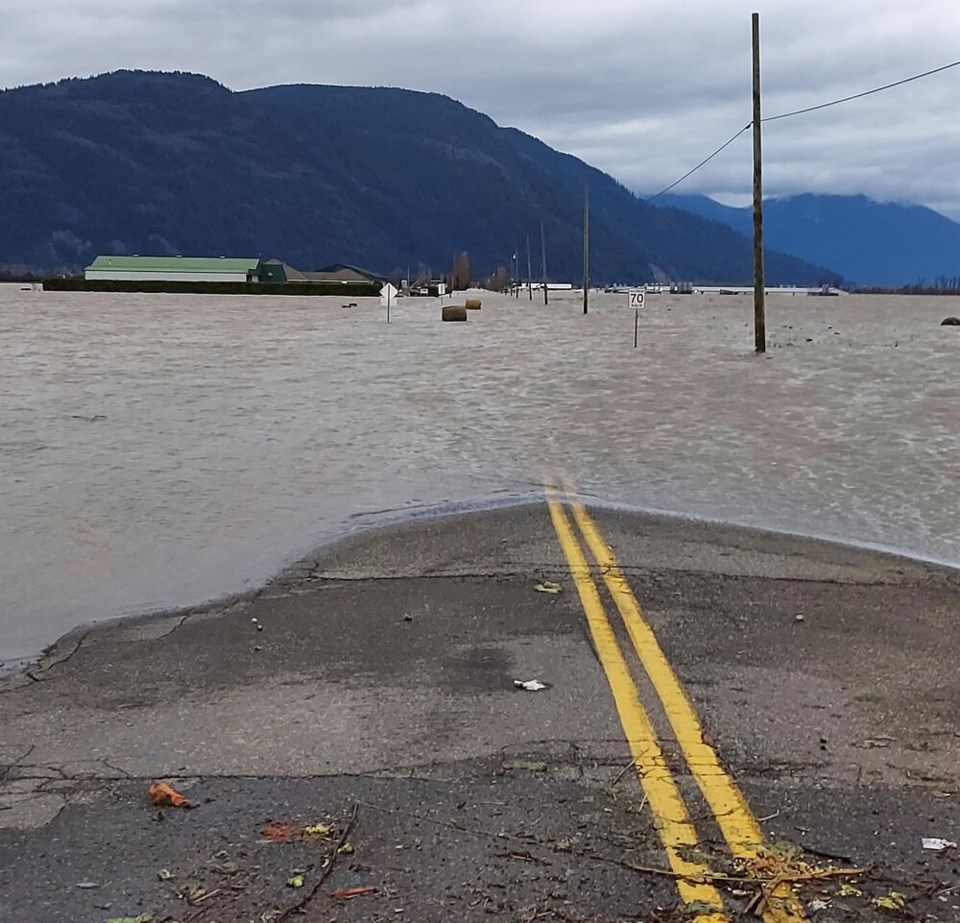Hundreds more British Columbians have been ordered to evacuate their homes over the past 24 hours after a third wave of heavy rainfall this week threatened further flooding and mudslides
At Sumas Mountain in Abbotsford, the city said there was an immediate danger to life due to an unstable slope along a stretch of Lower Sumas Road and Florence Drive. Earlier in the day, threats from landslides also prompted evacuation orders for residents of Glencoe Drive and North Parallel Road.
Residents were told to shut off all gas and electrical appliances, close all windows and doors and evacuate to an emergency shelter set up at a convention centre next to the airport.
“Get your family and, if you have room, take a neighbour,” wrote the city at 6 p.m. Nov. 30.
By 10 a.m. Wednesday, seven evacuation orders remained in effect across the Abbotsford neighbourhoods of Sumas Prairie, Huntingdon Village and Straiton Area.
There have been signs the worst effects of the storms have abated in Abbotsford. On Wednesday morning, the city’s police department said the rain had stopped and conditions were improving in the area south of Castle Fun Park.
Mayor Henry Braun is expected to provide an update on the ongoing crisis at 2 p.m. Dec. 1.
Elsewhere in the province, four evacuation orders remained in effect due to flooding and landslides in the Thompson-Nicola Regional District.
In Pemberton, 11 properties near Vine Road and Highway 99 were put on alert and told to prepare to evacuate. Heavy precipitation and snowmelt are expected to make their way downstream and raise water levels in the Lillooet River by Thursday, Dec. 2.
At 10 p.m. Nov. 30, landslide fears also triggered an evacuation order for 40 properties in the Squamish-Lillooet Regional District’s Electoral Area C near Birken. And in Princeton, several properties along the Similkameen River were told to leave immediately after an evacuation order went out at 1 p.m. Dec. 1.
The flooding has prompted Transport Canada to roll out recreational boating restrictions in an area covering Chilliwack and Coquihalla rivers. The ministry has also restricted all aircraft, including drones, from flying below 500 feet between the Abbotsford and Chilliwack airports until Dec. 4 at noon.
A total of 12 areas across the Fraser Valley Regional District are under evacuation orders, including places like Othello Road and Chilliwack Lake Road.
A day earlier, the chair of the regional district, Jason Lum, slammed the province for failing to approve emergency funding in a timely way.
Since Nov. 15, the province has approved 36 requests for emergency funding for the Fraser Valley Regional District, Public Safety Minister Mike Farnworth said Wednesday. Another six were rejected.
Farnworth defended his government's handling of the crisis, saying it works “very closely with local governments to ensure that we're able to get the resources, the assets, the equipment that they need to their communities as quickly as possible.”
STORM NOT OVER YET
As of Wednesday morning, the B.C. River Forecast Centre had issued flood warnings for a wide swathe of southwest B.C., including Metro Vancouver, the Fraser Valley, the Sea-to-Sky corridor, Merritt and the Fraser Valley up to Spences Bridge as well as south to the Similkameen River at Princeton.
Flood warnings are issued when river levels have exceeded their banks or will exceed them imminently, leading to flooding of nearby areas.
Despite a lull in rainfall Wednesday morning, the highest intensity precipitation is expected in the afternoon as a cold front sweeps through. Over 100 millimetres of rain has already fallen in the latest storm to hit B.C.’s coast. Up to 50 millimetres more rain is expected to fall into the evening in parts of the Fraser Valley.
“I want to make it clear to everyone,” said Minister Farnworth. “This storm is not over.”
The atmospheric rivers dumping rain on B.C. have also raised alpine temperatures to record levels across many ranges.
Environment Canada warning preparedness meteorologist Armel Castellan said that’s expected to trigger widespread snowmelt, further contributing to already flooded rivers.
Dave Campbell with the B.C. River Forecast Centre says snowmelt has already added another 50 to 60 millimetres of rainfall-equivalent melt water.
“Through the South Coast is really where we've seen quite significant rapid rising rivers around the Howe Sound and Fraser Valley areas,” he said.
The Nooksack River, a major contributor to flooding in Abbotsford, has been rising over the past 24 hours and conditions “remain challenging,” added Campbell, but it hasn’t reached the flood levels forecasters predicted.
Environment Canada is still working through all the new weather records broken in November. But Castellan said in places like Abbotsford, communities have broken their all-time November rainfall record by 99 millimetres — “a huge departure from the previous record going back many, many years.”
In addition, Victoria and Vancouver airports have broken total rainfall records for the period stretching through September, October and November.
“Without question, this has been a very active streak since mid-September, on the heels of an extremely dry and hot summer,” he said. “We have gone from some extremes to other extremes, and unfortunately this is consistent with what climate change has been projecting for all parts of Canada, including the mid-latitudes here in B.C.”
He added: “The frequency the amplitude of these events, and their longevity individually, will continue to increase with the coming years and decades.”





